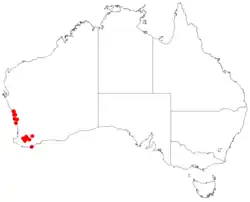Leucopogon ozothamnoides
| Leucopogon ozothamnoides | |
|---|---|
| Scientific classification | |
| Kingdom: | Plantae |
| Clade: | Tracheophytes |
| Clade: | Angiosperms |
| Clade: | Eudicots |
| Clade: | Asterids |
| Order: | Ericales |
| Family: | Ericaceae |
| Genus: | Leucopogon |
| Species: | L. ozothamnoides
|
| Binomial name | |
| Leucopogon ozothamnoides | |

| |
| Occurrence data from AVH | |
| Synonyms[1] | |
|
Styphelia ozothamnoides (Benth.) F.Muell. | |
Leucopogon ozothamnoides is a species of flowering plant in the heath family Ericaceae and is endemic to the south-west of Western Australia. It is a weak shrub that typically grows to a height of up to about 20 cm (7.9 in). Its leaves are egg-shaped and striated, 2.0–4.2 mm (0.079–0.165 in) long and pressed closely against the stem. In other respects, it is very similar to Leucopogon fimbriatus.[2][3]
The species was first formally described in 1868 by George Bentham in Flora Australiensis from specimens collected by Augustus Oldfield in a "dry sandy situation near Kinderup.[2][4] The specific epithet (ozothamnoides) means "Ozothamnus-like".[5]
Leucopogon ozothamnoides occurs in the Avon Wheatbelt and Jarrah Forest bioregions of south-western Western Australia and is listed "Priority One" by the Government of Western Australia Department of Biodiversity, Conservation and Attractions,[3] meaning that it is known from only one or a few locations which are potentially at risk.[6]
References
- ^ a b "Leucopogon ozothamnoides". Australian Plant Census. Retrieved 28 March 2023.
- ^ a b Bentham, George; von Mueller, Ferdinand (1868). Flora Australiensis. Vol. 4. London: Lovell Reeve & Co. p. 205. Retrieved 28 March 2023.
- ^ a b "Leucopogon ozothamnoides". FloraBase. Western Australian Government Department of Biodiversity, Conservation and Attractions.
- ^ "Leucopogon ozothamnoides". APNI. Retrieved 28 March 2023.
- ^ Sharr, Francis Aubi; George, Alex (2019). Western Australian Plant Names and Their Meanings (3rd ed.). Kardinya, WA: Four Gables Press. p. 268. ISBN 9780958034180.
- ^ "Conservation codes for Western Australian Flora and Fauna" (PDF). Government of Western Australia Department of Parks and Wildlife. Retrieved 28 March 2023.
